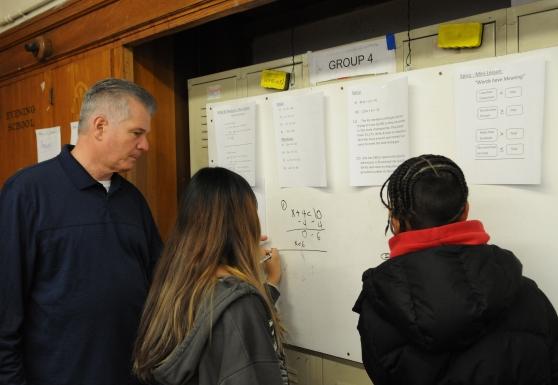Is it possible to transform a classroom where students imitate the teacher’s model to one of student exploration, collaboration, discussion and conceptual understanding? After reading a book called “Building Thinking Classrooms in Mathematics,” by Peter Liljedahl, I implemented three of his practices — random grouping, vertical nonpermanent surfaces and low-floor, high-ceiling questions — to promote greater engagement in my 7th-grade math classroom.
Random grouping: Homogeneous grouping can lead to students becoming comfortable working with only certain other students. It also increases the chance of being “labeled” while decreasing shared experiences and skill proficiencies.
Random grouping, by contrast, promotes knowledge mobility, where information and skills are transferred throughout the class. Students have the opportunity to work with a new group every day. The optimal group size is two to three members, which allows for sufficient discussion and contributions from each person. The key idea is to create groups with different students, working at various locations or stations, each and every day.

Whiteboards make students' learning visible to one another and to the teacher, and the ability to erase and start over can encourage students to take academic risks.
Vertical nonpermanent surfaces: Students stand at whiteboards while working together in small groups to solve problems of increasing difficulty. I purchased 32” x 48” markerboard panels from Lowe’s and installed them in my classroom, and students were immediately eager to work at them.
When students use whiteboards, thinking is visible to all students and everyone wants to have a turn at contributing to the group’s effort. Also, because whatever is written can be easily erased, students are more disposed to take academic risks and will more readily share their thinking with one another. If what is written is incorrect, it’s OK — just erase and start over.
The whiteboards allow the teacher to efficiently assess who is on task and moving ahead, who is productively struggling and may need support, and who is idle. I no longer peer over students’ shoulders to see their work and speak to the back of their heads: The work is clearly visible on the whiteboard, and I can speak to students face to face, which builds and fosters better relationships.
Low-floor, high-ceiling questions: Low-floor questions are the type every student in the class can answer while meeting the target objective, while high-ceiling questions are the challenging and complex types of questions that more accomplished students can manage. I create three sets of questions of increasing difficulty sequenced so the next problem is related to the one a student just solved.
Then I group these sets of questions into tiered tasks labeled mild, medium and spicy. Mild questions are introductory, offer procedural review and prepare students for the next set of questions. Medium questions are on grade level and are related to the particular standard we are learning — every student is expected to attempt those questions. Spicy questions extend the learning objective a grade or two and are more complex and challenging.
Students can choose the question set with which they’d like to work. If the questions are too difficult in that set, they can move down a level, or vice versa.
In a 55-minute block, my students usually spend about 30 to 35 minutes at whiteboards, followed by 20 to 25 minutes of independent work. All the activity of discovery, learning and assessment is high in energy — and time flies!
Shawn M. Donnelly has a doctorate in education and teaches math at Kingsborough Early College Secondary School, a grade 6-12 school in Brooklyn.